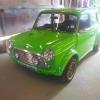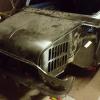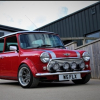
Opinions On Subframe Mounts Please
#1

Posted 30 December 2016 - 10:18 PM
It's for weekend plodding about so I'm not looking for a track car but I am leaning towards poly ?
Jim
#2

Posted 30 December 2016 - 10:25 PM
poly deforms, better with rubber or solid.
Solid are great, more feel, and less maintenance. The early minis were solid mounted front subframes. There is arguement about reinforcing the toe board for solid mounts, but ive never done it on a fast road car, driven hard and daily, never had issues with panels cracking etc.
#3

Posted 30 December 2016 - 10:26 PM
Fit rubber or fit solid mounts avoid poly at all costs.
Poly mounts are ludicrously flexible compared to a standard rubber mounts. They are essentially just a block of polyurathane with no internal structure unlike rubber mounts.
#4

Posted 30 December 2016 - 11:33 PM
#5

Posted 31 December 2016 - 12:00 AM
I haven't had a model that's had the rubber mounted front frames, however all our locally produced cars were solid from the factory (as pre MK1) and really, I've found no issues by having the front frame mounted this way.
While I've no experience with rubber mounted items, I do know all too well what a subframe is subject to and how it transmits that to the body. My only comment on Soft Mounting whether it be via rubber or poly is IMO, it's a bad idea and would lead to cracking of the body around the mounts.
#6

Posted 31 December 2016 - 12:14 AM
Solid for the true Mini steering response and feel. Rubber for older middle-aged lady drivers who like the car to be slightly smoother and less responsive.
Never, ever use poly-mountings.
Edited by Cooperman, 31 December 2016 - 12:15 AM.
#7

Posted 31 December 2016 - 02:28 AM
Having said that, so are the rubber toeboard mounts because they are not through-bolted to hold them together when the rubber debonds. When that happens, the inner wings may begin to crack near the front of the subframe towers, meaning that the nose of the car is distorting upwards. That will end badly if not spotted in time. It is difficult to get the front end back into proper shape so the cracks can be welded. I have first-hand experience of that, and the debonds rubbers were not visible until removed. It also shows that there is significant load on the front teardrop mounts, which some of the flip-fronters deny at their peril.
Alec designed the structure for a solid mounted subframe, and got it about right as the high torsional stiffness and general robustness of the assembled shell and subframes proves. It was some nameless person of much less experience and seemingly little competence who designed the rubber mount system, badly. The only sensible way to go is solid.
#8

Posted 31 December 2016 - 06:26 AM
I'm probably opening myself to some serious ridicule here, but i've yet to see any evidence that says polybushes deform, are more flexible than rubber bushes and inadequate for use. If anything they're probably more structurally sound that std bushes due to the new rubber compounds out there which are now proving not to last even a year in some applications!
I've used polybushes on all my previous cars without any issues (only the extra road noise). Even my last evo that had the entire car's standard rubber bushes replaced with poly and was then a track car for 6 years, not a single bush was perished or deformed on its rebuild. The mini goes through no more stresses than that on its critical mounts. Polyurethane is a strong compound when done correctly - there are a lot of side companies that throw them together and sell them cheaply. However, larger companies (powerflex, superflex etc) have a great reputation throughout the racing/rallying community.
They do not even have proper steel reinforcements.
Tiger - Which standard bushes on the mini are steel reinforced? (This is out of genuine curiosity, not a dig)
Edited by Steve220, 31 December 2016 - 06:29 AM.
#9

Posted 31 December 2016 - 06:53 AM
Something I will say before people use the 'rear mounts on front subframe' argument - I've spoken to powerflex about these. They have said they won't do this application because the original rubber mount is a poor design and would need redeveloping to become sufficient. I'll probably be going solid bushes on the front of my MPiT due to the torque i want to run.
#10

Posted 31 December 2016 - 08:00 AM
This was up on the Mini Spares website a few years back, not sure if it's still there now. It was penned by Keith Dodd;-
"Aftermarket bushes for suspension and subframes have been a topic of conversation for some time now. Many folk have become obsessed about fitting brightly coloured plastic (polyurethane) bushes in place of any rubber bush they can find in the belief they will improve the performance of whatever bush has been replaced. Whilst it is true that polyurethane is harder wearing - and therefore longer lasting - than rubber in many applications it is not necessarily the best material for the application every time. Polyurethane has greater abrasion resistance and is stiffer for a similar hardness, is much cheaper to produce (and therefore sells at lower cost) and can be produced in a wide variety of gaudy colours.
However, it does not posses the elasticity, vibration absorbance or deflection tolerance of rubber, pretty much why manufacturers use rubber on production cars instead of the cheaper polyurethane. A case in point (and what brought this subject to the fore) is bottom arm bushes used in competition where spherical rod ends are not allowed. Increasing the caster angle to improve handling distorts the inner bottom arm bush dramatically. The more caster angle used, the more dramatic the distortion. Whilst a rubber bush will tolerate this to a certain extent, a polyurethane bush will deform and stay deformed - adversely affecting the bush's performance and eventually failing in an unwanted - and possibly dramatic way - by falling out, split into several pieces. Ideally a rubber bush with a metal sleeve in it to reduce the quantity of rubber in the installation to improve stability and control is the way to go; especially if that metal insert is offset at an angle in the rubber to counter or reduce the deflection applied by greater caster angles than standard"
And in regards to Harder Tie Bar Rubbers a word or caution;-
"IMPORTANT NOTE
The use of very stiff or hard tie rod bushes on both side of the subframe bracket is most definitely NOT recommended.
Use the hard poly bush (often marked Minispares) on the outside only and the soft rubber bush on the inner side. This is to prevent the tie rod end shearing off through over-stressing when tightening up the retaining nut to achieve the required seating of the retaining washer against the step on the tie rod. These harder bushes on the outside are more than sufficien to create the increased stability desired. The tyre trying to drag the tie rod back through the subframe mainly causes the instability, therefore only the outer bushes requires increased resilience. (Usually, the bigger the tyre, the bigger the problem)
Fitting harder bushes on both sides does not noticeably improve stability, nor improve performance."
<Edit: This has also been my personal experience too. I'll also add that I was involved (under contract) during the 80's with a local Poly Bush Company in developing a range for the Minis, Metros and Mokes, many I fitted and tested on car and all tested in their Lab. I'll just close out by saying that following these extensive tests, I don't fit them to my own cars. >
Edited by Moke Spider, 31 December 2016 - 08:03 AM.
#11

Posted 31 December 2016 - 09:28 AM
#12

Posted 31 December 2016 - 09:48 AM
Jim
#13

Posted 31 December 2016 - 09:50 AM
I'm probably opening myself to some serious ridicule here, but i've yet to see any evidence that says polybushes deform, are more flexible than rubber bushes and inadequate for use. If anything they're probably more structurally sound that std bushes due to the new rubber compounds out there which are now proving not to last even a year in some applications!
I've used polybushes on all my previous cars without any issues (only the extra road noise). Even my last evo that had the entire car's standard rubber bushes replaced with poly and was then a track car for 6 years, not a single bush was perished or deformed on its rebuild. The mini goes through no more stresses than that on its critical mounts. Polyurethane is a strong compound when done correctly - there are a lot of side companies that throw them together and sell them cheaply. However, larger companies (powerflex, superflex etc) have a great reputation throughout the racing/rallying community.
Most bushes on modern cars like evo's are within a wishbone, control arm, mounting etc. On the mini subframe mount, the stress and twists are totally different from that of say a wishbone moving through a degree of movement. The poly bushes on the front subframe, twist and deform, the bolt holes become oblongated. They have metal inserts which the bolt passes through but still the poly ends up oblongated.
In reality, yes poly bushes are fine for certain applications and models, but for a mini front subframe they are just not suitable in my opinion.
#14

Posted 31 December 2016 - 09:51 AM
Thanks for the replies, I'm leaning towards solid for the true feel. I didn't know there was a problem with poly, which leaves me with the concern that I've built the rear subframe on poly ?
Jim
My concern with poly relates to the front. I had no problems with my rear subframe poly bushed (done before i got the car) and had no ill effects. The bushes are inside a mount, whereas the front subframe (particularly the lower rear to floor mounts) are open and become deformed.
#15

Posted 31 December 2016 - 10:47 AM
I've been thinking for some time that it would not be to difficult to re-design the rear mounting to carry the loads into the stiffer point on the shell where the loads were resolved on the early cars and as was intended. That would remove the possibility of the front bulkhead splitting with age and fatigue.
At the moment I don't have a later car to look at nor a single-bolt sub-frame as both my cars are 1964, but a simple fabricated fitting made from, maybe, 1.5 mm steel should be easy to do and it could be mounted to pick up where the MK.1 frames picked up and, perhaps, through the existing pick-up holes, i.e. 4 bolts per side through the floor/bulkhead.
Personally I never liked the idea of the entire front suspension, sub-frame and engine 'floating' on slightly 'iffy' rubber mountings when it was originally designed as an integral part of the vehicle's structural integrity putting the dynamic suspension loads and power-train stresses directly into the monocoque structure.
1 user(s) are reading this topic
0 members, 1 guests, 0 anonymous users


















